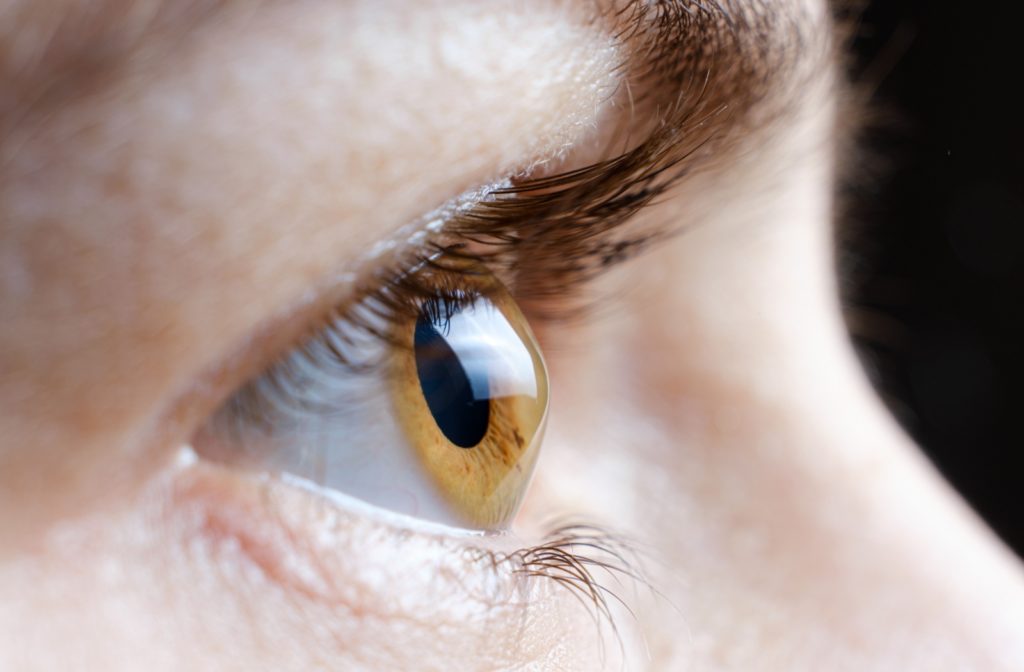Keratoconus is a condition characterized by the thinning and irregularities in the surface of the cornea. It only affects about 1 in 2,000 people, but can significantly impact your vision.
Keratoconus cannot be cured, however, the right treatments can stop keratoconus from worsening and improve your vision.
Read along for more information about keratoconus, including what it is, its symptoms, and different treatment options.
What Is Keratoconus?
Keratoconus is a condition where the surface of the cornea (the front part of the eye) grows in an unusual shape, becoming misshapen into a cone (like the end of a football) instead of round. The change in the cornea’s shape prevents light from entering the cornea, which leads to vision loss over time.
What Are the Symptoms of Keratoconus?
The symptoms of keratoconus can vary between individuals and might change as the disease progresses. Here are the most common symptoms associated with the condition:
- Blurry Vision: This is often one of the first signs of keratoconus. Individuals may notice that their vision gradually becomes blurry, which cannot be corrected completely using glasses. This blurriness can affect both near and far vision and often worsens over time.
- Sensitivity to Light: People with keratoconus often experience increased light sensitivity. This can be uncomfortable and may cause squinting in bright environments or when exposed to direct sunlight, fluorescent lights, or even vehicle headlights at night.
- Distorted Vision: Straight lines or regular patterns might appear bent or wavy. This is caused by the irregular curvature of the cornea distorting the way light rays are focused onto the retina. Common manifestations include seeing halos around lights and difficulties in night driving.
- Swelling of the Eye Area: As the cornea becomes more irregular and protrudes, it may lead to swelling in the eye area. This symptom can be exacerbated by eye rubbing, which is common among those experiencing discomfort due to keratoconus.
- Eye Redness: The strain and stress on the cornea and surrounding eye structures can cause chronic eye redness. This may not be constant but can flare up during periods of increased eye irritation or stress.
These symptoms can lead to a decrease in the quality of vision and may significantly affect daily activities, requiring individuals to seek corrective lenses or other forms of treatment to manage the condition.

How Is Keratoconus Diagnosed?
Keratoconus is diagnosed through an examination by a qualified optometrist. The optometrist measures the curvature of the cornea’s surface to make sure the cornea is maintaining a healthy shape. Regular eye exams are essential to catch any signs of keratoconus early and get the best possible treatment outcomes.
How Is Keratoconus Treated?
There are several different ways to treat keratoconus and its symptoms. Usually, optometrists will use a combination of both surgical and non-surgical approaches to treating keratoconus in their patients.
Soft Contact Lenses
Some of the symptoms of keratoconus, such as myopia (nearsightedness) and astigmatism, can be corrected with eyeglasses or soft contact lenses. Your optometrist can help you decide whether these options are right for you. However, treating the underlying cause of keratoconus (the change in the cornea’s shape) requires a special type of contact lens, called a scleral lens.
Scleral Contact Lenses
Scleral lenses are gas-permeable hard contact lenses, meaning they let your eye “breathe” while you wear them. They’re also larger than regular contact lenses, covering the entire white of the eye (the sclera) instead of just the cornea.
The larger size helps scleral lenses stay in place on the surface of the eye, even when the eye is an unusual shape, like in cases of keratoconus. Scleral lenses must be carefully fitted to the patient’s eye to be effective, meaning that you’ll need to see your optometrist for scleral lens consultations frequently.
Cross-Linking (Keratoconus Surgery)
Keratoconus is a progressive eye disease—meaning that it gets worse over time—because the cornea grows in an unusual shape. The misshapen cornea is a result of the collagen fibers in the eye becoming weakened. This causes the eye to grow abnormally, instead of in its normal spherical shape.
Ophthalmologists use a surgical procedure called corneal cross-linking to repair the damaged collagen fibers inside a patient’s cornea. By “cross-linking” the collagen fibers together, the eye’s shape becomes strengthened, and the eye will grow into a normal spherical shape. This stops keratoconus in its tracks.
This prevents the patient’s eye from growing in a conical shape again in the future so that the keratoconus doesn’t return. While this surgery prevents keratoconus from worsening, it does not reverse vision changes that have already happened.
Intacs Corneal Implants
Intacs are a pair of small, crescent-shaped, clear plastic implants. These are surgically placed into your cornea to give long-term vision correction, kind of like a permanent contact lens.
The lenses help to reshape the cornea over time, helping to prevent additional damage from keratoconus.
Corneal Transplant
For some keratoconus patients, a corneal transplant may be necessary. It’s also referred to as keratoplasty or a corneal graft.
This is another type of keratoconus surgery that is typically reserved for severe cases of keratoconus. Instead of this surgery trying to reshape your existing cornea, a new cornea is taken from a donor to replace the damaged cornea from keratoconus.
Additional Treatments
Depending on how severe your keratoconus is, your optometrist may recommend additional treatments to resolve any remaining vision problems. Because surgery can’t reverse changes caused by keratoconus, you might still need vision correction after surgery. This can include glasses lenses or contact lenses.
A comprehensive eye exam will allow your optometrist to help you determine the best care options for your situation.
The Next Steps in Your Keratoconus Treatment
If you or a family member have vision problems that suggest symptoms of keratoconus, our team of professionals at 2020 Eyecare Ohio can help. The sooner you schedule an exam with us, the sooner we can work together to make sure your eyes are as healthy as possible. Book an appointment with us today!



